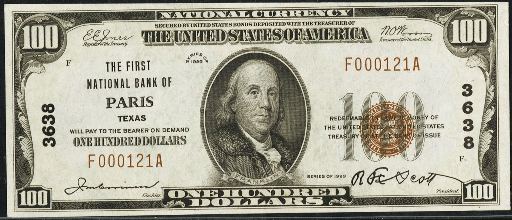The First National Bank Of Pueblo
The First National Bank Of Pueblo in Colorado printed $3,353,730 dollars worth of national currency. Over $1,000,000 face value is a lot of money. However, some types and denominations of currency from this bank could still be rare. This national bank opened in 1871 and stopped printing money in 1935, which equals a 65 year printing period. That is considering a long operation period for a national bank. During its life, The First National Bank Of Pueblo issued 14 different types and denominations of national currency. We have examples of the types listed below. Your bank note should look similar. Just the bank name will be different. For the record, The First National Bank Of Pueblo was located in Pueblo County. It was assigned charter number 1833.
We buy all national currency. Please call or email us for a quote. Sales@AntiqueMoney.com
The First National Bank Of Pueblo in Colorado issued 1,500 sheets of $1 original series territorial national bank notes. A total sheet output in the lows 1,000s is a great sign that you own a very rare bank note. When dealing with any first charter one dollar bank note, you can always take the number of sheets printed and multiply it by three to get the total number of actual bank notes printed for this denomination. These are technically called original series one dollar territorial national bank notes. Most collectors just call them territorial aces. Believe it or not, they are actually quite available. Around 100 of them are known to exist. Thanks to small hoards from towns like Salt Lake City, Yankton, and Denver, a collector can buy a nice looking territorial ace without spending tens of thousands of dollars. The rarest examples will certainly still cost more than $10,000, but others can seem like bargains.
Original Series $1 Territorial National Bank Note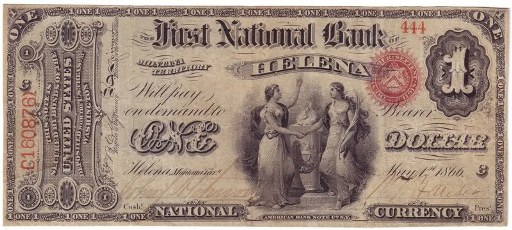
The First National Bank Of Pueblo printed 1,500 sheets of $2 original series territorial national bank notes. Keep in mind that there was just one two dollar bill printed per sheet. So in this case the sheet number equals the total output of notes. Just like with the one dollar denomination, original series $2 territorial bank notes have survived at a surprisingly high rate considering they were only issued by 19 different national banks. The good news for sellers is that these are still really valuable. Prices are as low as $10,000 for something ugly and relatively common. It is possible for the rarest examples to be worth more than $50,000.
Original Series $2 Territorial National Bank Note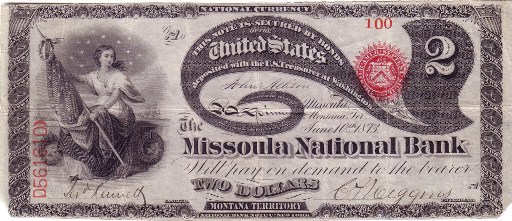
The First National Bank Of Pueblo also printed 3,375 sheets of $5 original series territorial national bank notes. Many territorial banks had outputs in the 2,000 to 4,000 range. You can do some quick math and take the sheet output, multiply it by four, and get the total number of original series $5 territorial bank notes issued by this bank. Only 30 banks in the country even printed these notes. Today there are only about ten surviving examples known to exist. Most of them are low grade and they are rarely available on the collector market. We are talking about bank notes printed before 1875, so the number of new discoveries being found 140 years later is minimal. Prices range from a few thousand dollars to tens of thousands of dollars based on any number of valuation factors.
Original Series $5 Territorial National Bank Note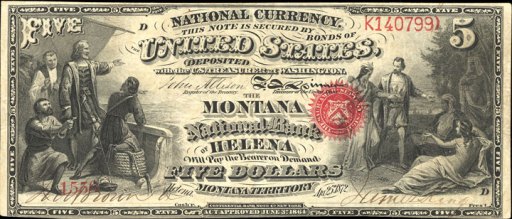
The First National Bank Of Pueblo also printed 12,750 sheets of $5 series of 1875 territorial national bank notes. It is unusual to see a sheet printed number over 10,000 when dealing with territorials, but that certainly doesn’t mean that these will automatically become common. Most first charter five dollar territorials that we encounter today are from the series of 1875. Despite saying series of 1875, these were actually printed as late as 1901 by a handful of banks. So while these might appear ancient, some are much newer than the series date would suggest. With that said, these are still rare items treasured by collectors. Exactly 42 national banks printed series of 1875 five dollar territorials. That list of banks pretty much included all of the territories from Arizona to Wyoming. Please give us a chance to help you establish the value of your note. You will likely be pleasantly surprised with how these bank notes are valued in today’s market.
Series of 1875 $5 Territorial National Bank Note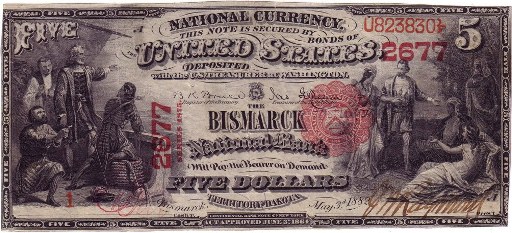
The First National Bank Of Pueblo also printed 12,899 sheets of $5 series of 1875 national bank notes. That is a high issue number for a national bank. You are likely not dealing with a rare bank note. However, the exact value is still based on condition and a number of other factors. You might be surprised at the value. Series of 1875 $5 bills are some of the most commonly encountered bank notes from the first charter series. Only the original series $1 bill is more available. Some banks exclusively issued five dollar bills. So if you want an example from one of those banks then you don’t have many options. These notes have a rounded red seal and red serial numbers. They also all have a red charter number.
Series of 1875 $5 National Bank Note
The First National Bank Of Pueblo also printed 6,725 sheets of $50 1882 brown back national bank notes. Not many banks printed $50 1882 brown backs. Sheet outputs aren’t extremely important. However, it is good factual information to know. The most common 1882 $50 brown backs are worth about $5,000. However, some can be worth more than $10,000 based on condition, serial number, and bank of issue.
Series of 1882 $50 Brown Back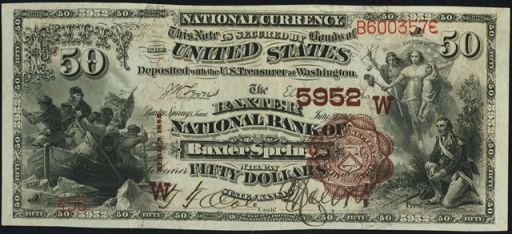
The First National Bank Of Pueblo also printed 6,725 sheets of $100 1882 brown back national bank notes. Just because this bank printed more than 1,000 one hundred dollar brown backs does not mean that they are all common. We are very interested in purchasing $100 1882 brown back national bank notes. We have paid more than $15,000 for some examples. Send us pictures of what you have and we will respond quickly with an appraisal and offer.
Series of 1882 $100 Brown Back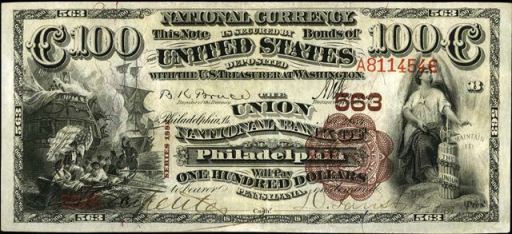
The First National Bank Of Pueblo also printed 2,770 sheets of $5 1882 blue seal national bank notes. That is a pretty standard sheet output number for these issues. Most of the value is going to be in the condition. 1882 $5 blue seal bank notes were issued by some national banks in The United States. While these are a somewhat rarer issue, they just aren’t especially popular with collectors. With exception of some minor differences, they look exactly like the earlier brown back series. Most collectors would prefer the brown back notes. With that said, some 1882 blue seals can still be worth thousands of dollars. So don’t just assume that what you have is automatically common.
1882 Blue Seal $5 National Bank Note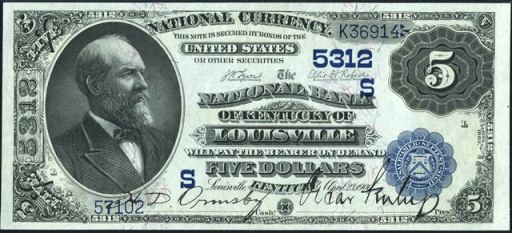
The First National Bank Of Pueblo also printed 3,000 sheets of $10 1902 blue seal national bank notes. Many small national banks could be in business for years and only print between 2,500 and 5,000 sheets of blue seals. 1902 $10 blue seal bank notes all have a portrait of William McKinley on them. Values can range from as little as $40 up to over $10,000. There really is no trick to know what is rare and what is common by just doing an internet search. You really need to work with an expert (like us) in order to determine the value of your specific bank note. There are at least ten different factors than can make some 1902 $10 blue seals worth more than others. We know exactly what to look for and we would be happy to provide a free appraisal and our best offer.
1902 $10 Blue Seal National Bank Note
The First National Bank Of Pueblo also printed 3,000 sheets of $20 1902 blue seal national bank notes. The same rarity rules for 1902 $10 blue seals also apply to $20 blue seals. Just remember that $20 bills are by nature three times rarer (unfortunately they don’t command a premium over other denominations). Hugh McCulloch is pictured on the front of each bill. Contact us if you need pricing help.
1902 $20 Blue Seal National Bank Note
The First National Bank Of Pueblo also printed 4,692 sheets of $50 1902 blue seal national bank notes. There is no trick to knowing which 1902 blue seals will be common and rare. Often times the number printed won’t tell you much information. The value still comes down to condition and demand. That is a surprise to most people. In fact, most 1902 $50 bills we see are worth between $750 and $1,250. The rarer ones can be worth more than $5,000. However, there isn’t much middle ground.
1902 $50 Blue Seal National Bank Note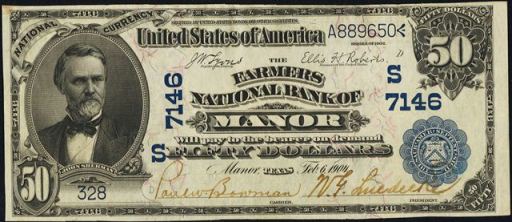
The First National Bank Of Pueblo also printed 4,692 sheets of $100 1902 blue seal national bank notes. It is no coincidence that the sheet numbers for $50 bills and $100 bills are the same. They were printed on the same sheets. Most $100 blue seals are at least scarce; others can be very rare. John J Knox is printed on the front of each bill. Most collectors like the back design a lot more though. It is really unique and different from most other national bank notes. Prices for 1902 $100 blue seals are pretty similar to $50 blue seals. They are both equally common or equally rare, depending on how you look at it.
1902 $100 Blue Seal National Bank Note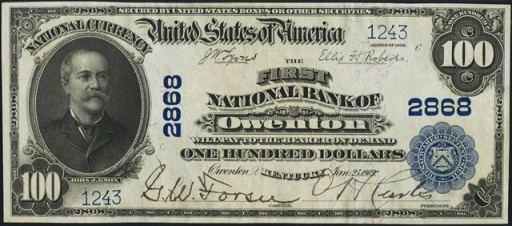
The First National Bank Of Pueblo also printed 1,210 sheets of Type1 1929 $50 national bank notes. That is a pretty typical sheet output for a national bank during the small size era. As is the case with all modern fifty dollar bills, Ulysses Grant is pictured on the front of 1929 $50 bills. This is a higher denomination that was only printed by 300 different national banks. Many examples are only worth around a few hundred dollars. Rarer specimens can sell for more than $1,000.
Series of 1929 Type1 $50 National Bank Note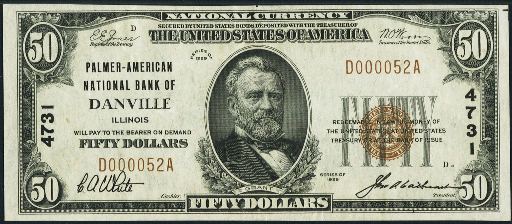
The First National Bank Of Pueblo also printed 451 sheets of Type1 1929 $100 national bank notes. That may sound like a very small number, and it is. However, when it comes to small size notes, that print range usually allows for a handful of survivors. Despite saying series of 1929, all type1 national bank notes were actually printed between 1929 and 1933. Exactly 289 national banks printed $100 type1 notes. Most are relatively common. However, as with anything, there are always exceptions to that rule.
Series of 1929 Type1 $100 National Bank Note